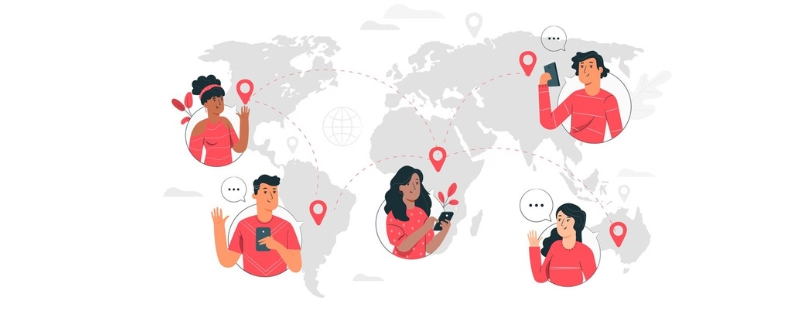
The Ultimate Guide to Roaming Regulations Across Different Regions
In today’s interconnected world, the ability to stay connected while traveling internationally is more important than ever. However, navigating the complex web of roaming regulations can be a daunting task for travelers. Each region has its own set of rules, pricing structures, and roaming agreements, which can significantly impact your communication experience and costs.
This comprehensive guide aims to demystify roaming regulations across various regions, helping you understand how to stay connected without incurring unexpected charges.
Understanding Roaming: The Basics
Roaming refers to the ability of your mobile device to connect to networks other than your home network when traveling abroad. This connection is made possible through agreements between your home network and the foreign network, enabling you to use voice, SMS, and data services outside your home country. However, roaming services are often accompanied by additional fees, which can vary significantly depending on the region, your mobile carrier, and the specific plan you are on.
Roaming Regulations in the European Union
The European Union (EU) has some of the most traveler-friendly roaming regulations in the world. Since June 2017, the “Roam Like at Home” initiative has allowed EU residents to use their mobile phones across all EU member states without incurring additional roaming charges. Under this regulation:
- No Extra Charges: Calls, texts, and data used while roaming in the EU are billed at the same rates as at home, subject to a fair use policy.
- Fair Use Policy: Carriers can set limits on data usage to prevent abuse. If you exceed these limits, a surcharge may apply, but it is capped to ensure costs remain reasonable.
- Emergency Services: Free access to emergency services (112) is guaranteed, regardless of roaming status.
While this regulation is highly beneficial for EU travelers, it is crucial to check with your carrier before departure to understand any specific limitations or conditions that might apply to your plan.
Roaming Regulations in Europe Outside the EU
While the European Union (EU) offers a unified roaming framework under the “Roam Like at Home” initiative, many European countries remain outside the EU. These countries have distinct roaming regulations and policies that can lead to varying costs for travelers. It’s essential to understand these differences to manage your roaming charges effectively when traveling across Europe.
Switzerland: A Special Case in Europe
Switzerland, although geographically at the center of Europe, is not a member of the EU, and this status affects its roaming policies:
- Not Part of “Roam Like at Home”: Switzerland is excluded from the EU’s “Roam Like at Home” regulation, meaning roaming charges for calls, SMS, and data can be significantly higher for both EU and non-EU travelers.
- Different Rates by Providers: Roaming rates vary greatly depending on the provider. Some European carriers include Switzerland in their packages or offer specific add-ons to reduce costs, while others treat it as a “Rest of the World” destination, resulting in higher charges.
- Local SIM Cards: For extended stays, purchasing a local Swiss SIM card can be a cost-effective option, providing affordable data and call plans compared to international roaming.
Norway, Iceland, and Liechtenstein: EEA Countries
Norway, Iceland, and Liechtenstein are part of the European Economic Area (EEA) but not the EU. However, they have adopted the EU’s “Roam Like at Home” policy, which means:
- Roaming Like at Home: Travelers from EEA countries can enjoy the same roaming benefits as within the EU, with no additional charges for using their mobile phones in these countries.
- Fair Use Policies Apply: As with EU countries, fair use policies may apply, particularly concerning data usage, to prevent excessive or abusive use.
The United Kingdom: Post-Brexit Roaming Rules
Following Brexit, the United Kingdom is no longer subject to the EU’s “Roam Like at Home” regulation, and roaming rules have changed:
- No Automatic Free Roaming: UK travelers to the EU and EU travelers to the UK may face roaming charges, depending on their carriers. Some UK mobile operators have reinstated roaming fees, while others have maintained free roaming as a competitive offering.
- Check Carrier Policies: It is essential for travelers to check with their mobile providers to understand specific charges and available packages for roaming between the UK and EU countries.
- Alternative Options: Using local SIM cards or purchasing specific EU roaming add-ons from UK providers can help manage costs.
Western Balkans: Albania, Serbia, North Macedonia, Bosnia and Herzegovina, Kosovo, and Montenegro
The Western Balkans region is not part of the EU, and roaming charges can vary significantly:
- Roaming Agreements: Some countries in this region have bilateral or regional agreements to reduce roaming costs for their citizens, but these do not generally apply to EU or other international travelers.
- High Roaming Costs: Without such agreements, roaming in the Western Balkans can be expensive. It is often recommended to purchase local SIM cards or consider roaming packages from your home provider that include this region.
- Future Integration: Efforts are underway to align the region’s telecommunication standards with the EU, which may lead to reduced roaming costs in the future. However, this process is still ongoing, and travelers should check current rates and conditions.
Turkey: A Different Regulatory Environment
Turkey presents a unique situation with its own roaming policies:
- Not Covered by EU Regulations: Turkey is not part of the EU or EEA, so the “Roam Like at Home” regulation does not apply. Roaming charges for EU and non-EU travelers can be quite high.
- Variable Charges: The cost of roaming in Turkey can vary widely depending on the provider. Some European carriers offer specific roaming packages for Turkey, while others may treat it as a high-cost destination.
- Local SIM Options: Purchasing a local Turkish SIM card or using an international eSIM service can be a more cost-effective way to stay connected.
Other Non-EU European Countries: Russia, Ukraine, and the Caucasus
For travelers visiting Russia, Ukraine, Georgia, Armenia, and Azerbaijan, the roaming situation can vary:
- Russia: Roaming in Russia can be expensive due to the country’s unique telecommunication environment. Local SIM cards are readily available and can offer much more affordable rates than international roaming.
- Ukraine: Since the geopolitical situation in Ukraine is complex, roaming agreements can change rapidly. Travelers should check with their providers for the most current information on charges and service availability. Local SIM cards are generally the most affordable option.
- Caucasus Region (Georgia, Armenia, Azerbaijan): Each of these countries has its own set of roaming regulations, and international roaming charges can be steep. Travelers are often advised to buy local SIM cards to avoid high costs.
Roaming Regulations in the United States and Canada
Roaming in North America is governed primarily by agreements between carriers, with no overarching government regulations like those in the EU. Here’s what you need to know:
- United States: U.S. carriers, such as AT&T, Verizon, and T-Mobile, typically offer specific roaming packages for international travel. Domestic roaming within the U.S. is generally free across all states, but international roaming can come with steep charges unless covered by an international plan.
- Canada: Canadian carriers, including Bell, Rogers, and Telus, often provide cross-border roaming packages that include the U.S. Most plans come with a daily fee for accessing your domestic plan benefits while in the U.S., and rates for roaming outside North America can be significantly higher.
When roaming within North America, consider carrier-specific roaming plans that offer bundled services at discounted rates to avoid excessive charges.
Roaming Regulations in South America
South America presents a unique set of challenges and opportunities for travelers looking to stay connected while moving across different countries. Unlike regions like the EU, South America lacks a unified roaming framework, so costs and policies can vary significantly depending on the country and the mobile provider.
Roaming in Specific South American Countries
- Brazil:
- Roaming Costs: Brazil typically has high roaming costs for international travelers. However, several local providers offer competitive rates for data and calling plans.
- Local SIM Cards: Readily available and a popular choice for travelers. SIM cards from major providers like Vivo, Claro, or TIM can be bought at the airport or local shops.
- Argentina:
- Roaming Costs: Costs can vary depending on your home provider and their agreements with local carriers like Movistar, Claro, or Personal. Rates tend to be high without a specific international plan.
- Local SIM Cards: A good alternative, especially for extended stays. Local SIM cards are inexpensive and provide access to affordable data packages.
- Chile:
- Roaming Costs: Generally high for international travelers, particularly for data usage. Some European and North American carriers have agreements that provide better rates, but it’s essential to check beforehand.
- Local SIM Cards: Available from providers like Entel, Movistar, and WOM, offering reasonable rates for data and voice services.
- Colombia:
- Roaming Costs: Similar to other South American countries, roaming can be costly, particularly for data. It is advisable to explore local or regional packages.
- Local SIM Cards: Local SIMs from carriers like Claro, Movistar, and Tigo are affordable and provide a range of data options suitable for travelers.
- Peru:
- Roaming Costs: Travelers should expect high roaming costs unless they have a carrier with specific agreements. The use of local SIM cards or eSIMs is recommended.
- Local SIM Cards: Easy to find and purchase from major carriers like Claro, Movistar, and Bitel.
Roaming Regulations in Asia
Asia is a diverse region with varying roaming regulations depending on the country. Here are some notable examples:
- Japan and South Korea: Both countries have well-established networks, and many carriers have reciprocal agreements with international providers. Roaming charges can be high, but numerous carriers offer travel-specific SIM cards and pocket WiFi options that can provide cheaper alternatives to traditional roaming.
- China: Roaming in China can be complicated due to different network standards and regulations. Foreign SIM cards may not work seamlessly, and data roaming charges can be steep. Travelers are advised to purchase local SIM cards or opt for global roaming packages from their home providers.
- India and Southeast Asia: Roaming rates vary widely across countries. India and many Southeast Asian countries have competitive local SIM markets, making it easy for travelers to access affordable data and call services. However, using your home SIM for roaming can still incur significant charges, so it’s often more cost-effective to purchase a local SIM upon arrival.
Roaming Regulations in Africa
Roaming across Africa can be complex due to the lack of unified regulations and the diverse telecommunications landscape. Some key points to consider:
- South Africa: While South Africa offers some of the most developed mobile networks in Africa, roaming can be expensive. Local SIM cards or data bundles from home carriers can provide more affordable options.
- East and West Africa: Countries like Kenya, Nigeria, and Ghana have relatively developed mobile markets, but roaming charges remain high due to limited international agreements. Travelers should explore local SIM options or consider international roaming packages from their carriers.
- Northern Africa: Roaming services in North African countries like Egypt, Morocco, and Tunisia are generally well-developed, but prices vary significantly. It’s advisable to check with your carrier for specific roaming rates before travel.
Roaming Regulations in the Middle East
The Middle East presents a varied landscape for roaming charges, heavily influenced by the regulatory environment and the presence of both local and international telecom operators:
- United Arab Emirates (UAE) and Saudi Arabia: These countries have well-developed telecommunications networks, but roaming fees can be high. Purchasing local SIM cards or data plans upon arrival can often provide more affordable options than using international roaming.
- Israel and Turkey: These countries have reciprocal roaming agreements with many European and North American carriers. However, costs can still vary, so checking with your provider for specific rates and options is essential.
Roaming Regulations in Australia and Oceania
Australia and Oceania offer robust mobile networks, but roaming costs can differ significantly:
- Australia and New Zealand: Both countries have competitive mobile markets, and many carriers offer affordable roaming packages. International roaming charges can be high without a dedicated plan, so purchasing a local SIM card or a specific travel package from your provider is often recommended.
- Pacific Islands: Roaming in the Pacific Islands can be expensive due to limited infrastructure and high operational costs. Many travelers find it more economical to purchase local SIM cards or rely on WiFi-based communication apps.
Tips for Managing Roaming Costs
To avoid unexpected charges and manage your roaming costs effectively, consider the following tips:
- Check Roaming Packages: Contact your provider before departure to understand your roaming options and available packages that might offer discounted rates.
- Use Local SIM Cards: For longer stays, purchasing a local SIM card is often the most economical choice.
- Leverage WiFi Hotspots: Whenever possible, connect to local WiFi networks to minimize data usage.
- Monitor Usage: Keep track of your data, call, and SMS usage to avoid exceeding any plan limits or fair usage policies.
- Consider eSIM Options: Many modern smartphones support eSIM technology, allowing you to switch between different carriers and plans without the need for a physical SIM card.
Conclusion
Understanding the diverse landscape of roaming regulations across different regions is key to avoiding costly surprises while traveling. By planning ahead, understanding your carrier’s roaming agreements, and considering alternative options like local SIM cards or dedicated travel packages, you can stay connected wherever you go without breaking the bank. Always research your specific destination’s regulations and options to ensure the best possible connectivity experience.












